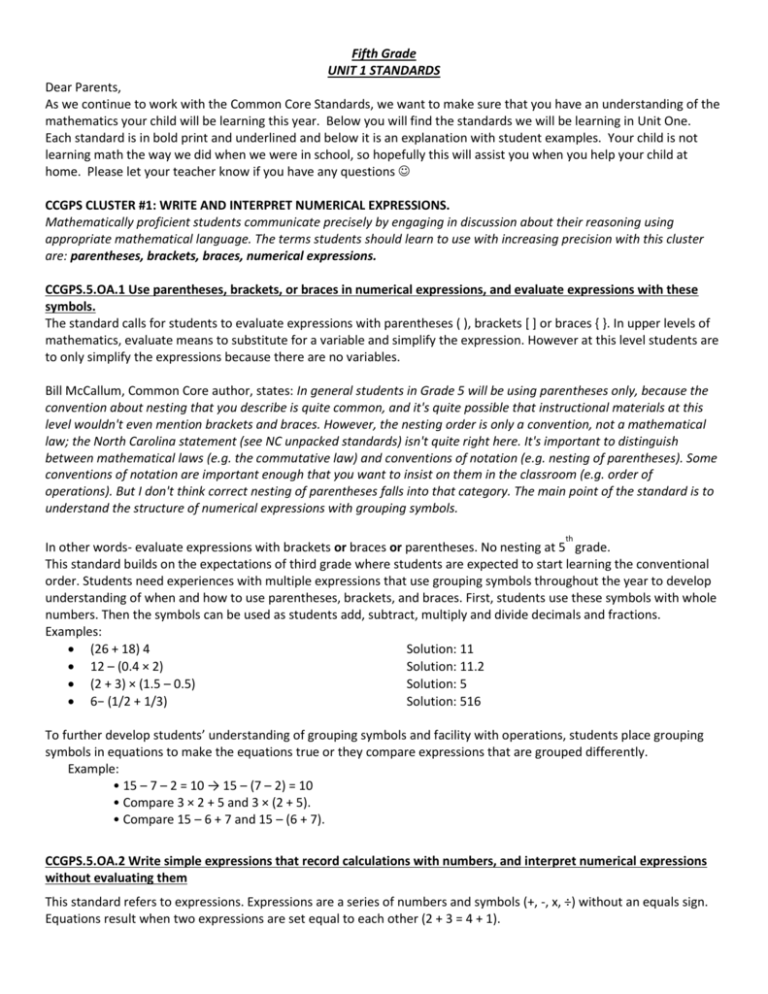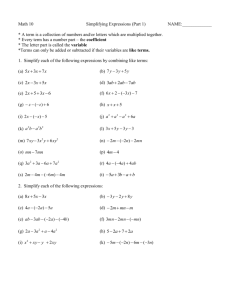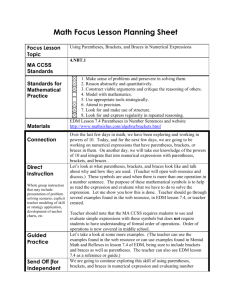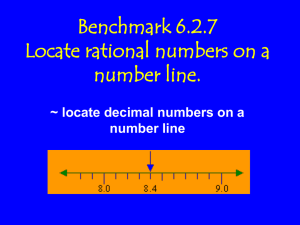Fifth Grade unit 1
advertisement

Fifth Grade
UNIT 1 STANDARDS
Dear Parents,
As we continue to work with the Common Core Standards, we want to make sure that you have an understanding of the
mathematics your child will be learning this year. Below you will find the standards we will be learning in Unit One.
Each standard is in bold print and underlined and below it is an explanation with student examples. Your child is not
learning math the way we did when we were in school, so hopefully this will assist you when you help your child at
home. Please let your teacher know if you have any questions
CCGPS CLUSTER #1: WRITE AND INTERPRET NUMERICAL EXPRESSIONS.
Mathematically proficient students communicate precisely by engaging in discussion about their reasoning using
appropriate mathematical language. The terms students should learn to use with increasing precision with this cluster
are: parentheses, brackets, braces, numerical expressions.
CCGPS.5.OA.1 Use parentheses, brackets, or braces in numerical expressions, and evaluate expressions with these
symbols.
The standard calls for students to evaluate expressions with parentheses ( ), brackets [ ] or braces { }. In upper levels of
mathematics, evaluate means to substitute for a variable and simplify the expression. However at this level students are
to only simplify the expressions because there are no variables.
Bill McCallum, Common Core author, states: In general students in Grade 5 will be using parentheses only, because the
convention about nesting that you describe is quite common, and it's quite possible that instructional materials at this
level wouldn't even mention brackets and braces. However, the nesting order is only a convention, not a mathematical
law; the North Carolina statement (see NC unpacked standards) isn't quite right here. It's important to distinguish
between mathematical laws (e.g. the commutative law) and conventions of notation (e.g. nesting of parentheses). Some
conventions of notation are important enough that you want to insist on them in the classroom (e.g. order of
operations). But I don't think correct nesting of parentheses falls into that category. The main point of the standard is to
understand the structure of numerical expressions with grouping symbols.
th
In other words- evaluate expressions with brackets or braces or parentheses. No nesting at 5 grade.
This standard builds on the expectations of third grade where students are expected to start learning the conventional
order. Students need experiences with multiple expressions that use grouping symbols throughout the year to develop
understanding of when and how to use parentheses, brackets, and braces. First, students use these symbols with whole
numbers. Then the symbols can be used as students add, subtract, multiply and divide decimals and fractions.
Examples:
(26 + 18) 4
Solution: 11
12 – (0.4 × 2)
Solution: 11.2
(2 + 3) × (1.5 – 0.5)
Solution: 5
6− (1/2 + 1/3)
Solution: 516
To further develop students’ understanding of grouping symbols and facility with operations, students place grouping
symbols in equations to make the equations true or they compare expressions that are grouped differently.
Example:
• 15 – 7 – 2 = 10 → 15 – (7 – 2) = 10
• Compare 3 × 2 + 5 and 3 × (2 + 5).
• Compare 15 – 6 + 7 and 15 – (6 + 7).
CCGPS.5.OA.2 Write simple expressions that record calculations with numbers, and interpret numerical expressions
without evaluating them
This standard refers to expressions. Expressions are a series of numbers and symbols (+, -, x, ÷) without an equals sign.
Equations result when two expressions are set equal to each other (2 + 3 = 4 + 1).
Example:
•
•
•
4(5 + 3) is an expression.
When we compute 4(5 + 3) we are evaluating the expression. The expression equals 32.
4(5 + 3) = 32 is an equation.
This standard calls for students to verbally describe the relationship between expressions without actually calculating
them. This standard calls for students to apply their reasoning of the four operations as well as place value while
describing the relationship between numbers. The standard does not include the use of variables, only numbers and
signs for operations.
Example:
Write: Write an expression for the steps “double five and then add 26.
Student: (2 × 5) + 26
Interpret: Describe how the expression 5(10 × 10) relates to 10 × 10.
Student: The expression 5(10 × 10) is 5 times larger than the expression 10 × 10 since I know
that I that 5(10 × 10) means that I have 5 groups of (10 × 10).
Common Misconceptions
Students may believe the order in which a problem with mixed operations is written is the order to solve the problem.
Allow students to use calculators to determine the value of the expression, and then discuss the order the calculator
used to evaluate the expression. Do this with four-function and scientific calculators.
CCGPS.5.NBT.2 Explain patterns in the number of zeros of the product when multiplying a number by powers of 10,
and explain patterns in the placement of the decimal point when a decimal is multiplied or divided by a power of 10.
Use whole-number exponents to denote powers of 10.
This standard includes multiplying by multiples of 10 and powers of 10, including 102 which is 10 10=100, and 103
which is 10 10 10 =1,000. Students should have experiences working with connecting the pattern of the number of
zeros in the product when you multiply by powers of 10.
Examples:
2.5 103 = 2.5 (10 10 10) = 2.5 1,000 = 2,500
Students should reason that the exponent above the 10 indicates how many places the decimal point is moving (not just
that the decimal point is moving but that you are multiplying or making the number 10 times greater three times) when
you multiply by a power of 10. Since we are multiplying by a power of 10 the decimal point moves to the right.
350 ÷ 103 = 350 ÷ 1,000 = 0.350 = 0.35
350
/10 = 35
(35 1/10)
(350 1/10)
3.5
/10 = 0.35
35
/10 = 3.5
(3.5 1/10)
This will relate well to subsequent work with operating with fractions. This example shows that when we divide by
powers of 10, the exponent above the 10 indicates how many places the decimal point is moving (how many times we
are dividing by 10 , the number becomes ten times smaller). Since we are dividing by powers of 10, the decimal point
moves to the left.
Students need to be provided with opportunities to explore this concept and come to this understanding; this should
not just be taught procedurally.
Examples:
Students might write:
36 10 = 36 101 = 360
36 10 10 = 36 102 = 3600
36 10 10 10 = 36 103 = 36,000
36 10 10 10 10 = 36 104 = 360,000
Students might think and/or say:
I noticed that every time, I multiplied by 10 I added a zero to the end of the number. That makes sense because each
digit’s value became 10 times larger. To make a digit 10 times larger, I have to move it one place value to the left.
When I multiplied 36 by 10, the 30 became 300. The 6 became 60 or the 36 became 360. So I had to add a zero at the
end to have the 3 represent 3 one-hundreds (instead of 3 tens) and the 6 represents 6 tens (instead of 6 ones).
Students should be able to use the same type of reasoning as above to explain why the following multiplication and
division problem by powers of 10 make sense.
523 103 = 523,000
The place value of 523 is increased by 3 places.
5.223 102 = 522.3
The place value of 5.223 is increased by 2 places.
52.3 ÷ 101 = 5.23
The place value of 52.3 is decreased by one place.
CCGPS CLUSTER #2: PERFORM OPERATIONS WITH MULTI-DIGIT WHOLE NUMBERS AND WITH DECIMALS TO
HUNDREDTHS.
Students develop understanding of why division procedures work based on the meaning of base-ten numerals and
properties of operations. They finalize fluency with multi-digit addition, subtraction, multiplication, and division. They
apply their understandings of models for decimals, decimal notation, and properties of operations to add and subtract
decimals to hundredths. They develop fluency in these computations, and make reasonable estimates of their results.
Students use the relationship between decimals and fractions, as well as the relationship between finite decimals and
whole numbers (i.e., a finite decimal multiplied by an appropriate power of 10 is a whole number), to understand and
explain why the procedures for multiplying and dividing finite decimals make sense. They compute products and
quotients of decimals to hundredths efficiently and accurately. Mathematically proficient students communicate
precisely by engaging in discussion about their reasoning using appropriate mathematical language. The terms students
should learn to use with increasing precision with this cluster are: multiplication/multiply, division/division, decimal,
decimal point, tenths, hundredths, products, quotients, dividends, rectangular arrays, area models, addition/add,
subtraction/subtract, (properties)-rules about how numbers work, reasoning.
CCGPS.5.NBT.5 Fluently multiply multi-digit whole numbers using the standard algorithm.
This standard refers to fluency which means accuracy (correct answer), efficiency (a reasonable amount of steps), and
flexibility (using strategies such as the distributive property or breaking numbers apart also using strategies according to
the numbers in the problem, 26 4 may lend itself to (25 4) + 4 where as another problem might lend itself to making
an equivalent problem 32 4 = 64 2. This standard builds upon students’ work with multiplying numbers in 3rd and 4th
grade. In 4th grade, students developed understanding of multiplication through using various strategies. While the
standard algorithm is mentioned, alternative strategies are also appropriate to help students develop conceptual
understanding. The size of the numbers should NOT exceed a three-digit factor by a two-digit factor.
Examples of alternative strategies:
There are 225 dozen cookies in the bakery. How many cookies are there?
Student 1
Student 2
225 12
I broke 12 up into 10 and 2.
225 10 = 2,250
225 2 = 450
2,250 + 450 = 2,700
Student 3
225 12
I broke 225 up into 200 and
25.
200 12 = 2,400
I broke 25 up into 5 5, so I
had 5 5 12 or 5 12 5.
I doubled 225 and cut 12 in
half to get 450 6. Then I
doubled 450 again and cut 6
in half to 900 3.
900 3 = 2,700
5 12 = 60
60 5 = 300
Then I added 2,400 and 300.
2,400 + 300 = 2,700
Draw an array model for 225 12 200 10, 200 2, 20 10, 20 2, 5 10, 5 2.
CCGPS.5.NBT.6 Find whole-number quotients of whole numbers with up to four-digit dividends and two-digit
divisors, using strategies based on place value, the properties of operations, and/or the relationship between
multiplication and division. Illustrate and explain the calculation by using equations, rectangular arrays, and/or area
models.
This standard references various strategies for division. Division problems can include remainders. Even though this
standard leads more towards computation, the connection to story contexts is critical. Make sure students are exposed
to problems where the divisor is the number of groups and where the divisor is the size of the groups. In 4th grade,
students’ experiences with division were limited to dividing by one-digit divisors. This standard extends students’ prior
experiences with strategies, illustrations, and explanations. When the two-digit divisor is a “familiar” number, a student
might decompose the dividend using place value.
Example:
There are 1,716 students participating in Field Day. They are put into teams of 16 for the competition. How many teams
get created? If you have left over students, what do you do with them?
Student 1
Student 2
1,716 16
There are 100 16’s in 1,716.
1,716 – 1,600 = 116
I know there are at least 6 16’s in 116.
116 – 96 = 20
I can take out one more 16.
20 – 16 = 4
1,716 16
There are 100 16’s in
1,1716.
Ten groups of 16 is 160.
That’s too big. Half of that
is 80, which is 5 groups.
I know that 2 groups of
16’s is 32.
There were 107 teams with 4 students left
over. If we put the extra students on different
teams, 4 teams will have 17 students.
I have 4 students left over.
Student 3
Student 4
1,716 ÷ 16
I want to get to 1,716. I know that 100 16’s
equals 1,600. I know that 5 16’s equals 80.
1,600 + 80 = 1,680
Two more groups of 16’s equals 32, which
gets us to 1,712. I am 4 away from 1,716.
How many 16’s are in 1,716?
We have an area of 1,716. I know that one
side of my array is 16 units long. I used 16 as
the height. I am trying to answer the question:
What is the width of my rectangle if the area is
1,716 and the height is 16?
So we had 100 + 6 + 1 = 107 teams. Those
other 4 students can just hang out.
1,716 – 1,600 = 116
116 – 112 = 4
100 + 7 = 107 R 4
Examples:
Using expanded notation: 2682 ÷ 25 = (2000 + 600 + 80 + 2) ÷ 25
Using understanding of the relationship between 100 and 25, a student might think:
o I know that 100 divided by 25 is 4 so 200 divided by 25 is 8 and 2000 divided by 25 is 80.
o 600 divided by 25 has to be 24.
o Since 3 25 is 75, I know that 80 divided by 25 is 3 with a reminder of 5. (Note that a student
might divide into 82 and not 80.)
o I can’t divide 2 by 25 so 2 plus the 5 leaves a remainder of 7.
o 80 + 24 + 3 = 107. So, the answer is 107 with a remainder of 7.
Using an equation that relates division to multiplication, 25 n = 2682, a student might estimate the
answer to be slightly larger than 100 because s/he recognizes that 25 100 = 2500.
Example: 968 ÷ 21
Using base ten models, a student can represent 962 and use the models to make an array with one
dimension of 21. The student continues to make the array until no more groups of 21 can be made.
Remainders are not part of the array.
Example: 9984 ÷ 64
An area model for division is shown below. As the student uses the area model, s/he keeps track of how much of the
9984 is left to divide.







